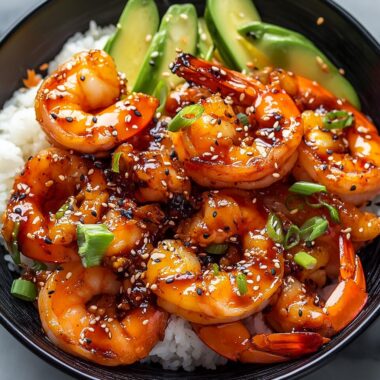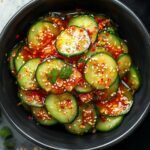The Korean Gochujang Cucumber Salad is a bold and refreshing side dish that brings the perfect balance of spice, tang, and crunch to your table. It’s a traditional Korean banchan that pairs beautifully with grilled meats, rice dishes, or can even stand alone as a light and zesty snack. Thanks to the gochujang’s deep umami flavor, combined with the crisp freshness of cucumber and the nutty hint of sesame, this dish is as visually appealing as it is delicious. Ready in minutes, it’s an excellent choice for anyone wanting a punchy, healthy dish that wakes up the palate.
Full recipe:
Ingredients:
-
2 large cucumbers, thinly sliced
-
1 tablespoon sea salt
-
1 tablespoon rice vinegar
-
1 tablespoon gochujang (Korean red chili paste)
-
1 teaspoon sesame oil
-
1 teaspoon sugar
-
1 clove garlic, finely minced
-
1 teaspoon soy sauce
-
1 tablespoon toasted sesame seeds
-
1 green onion, thinly sliced
Directions:
-
Thinly slice the cucumbers and place them in a colander. Sprinkle with sea salt, toss, and let sit for 15-20 minutes to draw out moisture.
-
Rinse the cucumbers under cold water to remove excess salt. Drain well and gently squeeze out extra water using a clean kitchen towel or paper towels.
-
In a mixing bowl, combine gochujang, rice vinegar, sesame oil, sugar, garlic, and soy sauce. Stir well until smooth.
-
Add the cucumbers to the bowl and toss to coat them evenly with the dressing.
-
Sprinkle with toasted sesame seeds and green onions.
-
Chill for at least 10 minutes before serving for the flavors to meld.
Prep Time: 20 minutes (including salting time) | Cooking Time: 0 minutes | Total Time: 20 minutes
Kcal: 60 kcal | Servings: 4 servings
Origins of Korean Gochujang Cucumber Salad
Korean cuisine is widely celebrated for its vibrant flavors, bold use of spices, and balanced presentation of texture and taste. One classic example of this is the Korean Gochujang Cucumber Salad, also known as Oi Muchim (오이무침). This dish is a type of banchan, which are the small side dishes served alongside main meals in Korean dining.
Oi Muchim translates directly to “seasoned cucumber,” and it is a common homemade favorite in Korea due to its simplicity and versatility. The use of gochujang, a fermented red chili paste, gives this salad its signature heat and complexity. While traditional cucumber salads around the world tend to be cooling or subtly seasoned, the Korean version stands out with its spicy, tangy, and savory profile that wakes up the palate.
What is Gochujang and Why Is It Special?
At the heart of this salad is gochujang, one of Korea’s most iconic ingredients. Made from chili powder, glutinous rice, fermented soybeans, and salt, gochujang undergoes a long fermentation process that gives it an umami-rich, slightly sweet heat unlike any other chili paste in the world.
It’s not just spicy—gochujang is layered. Its flavor is deep, earthy, and bold, with a fermented punch that can enhance even the simplest of ingredients. When paired with fresh, crisp cucumber, it creates a dish that’s not only flavorful but also offers a refreshing balance of heat and coolness.
This flavor pairing is what makes the Korean Gochujang Cucumber Salad so addictive. The cucumbers act as a neutral base that soaks up the boldness of the dressing without being overwhelmed.
Nutritional Benefits of Korean Cucumber Salad
Cucumbers are a low-calorie, hydrating vegetable that are high in water content and rich in vitamins and antioxidants. This salad is a fantastic way to enjoy a healthy, guilt-free snack or side dish.
Some of the key nutritional benefits include:
- Hydration: Cucumbers are composed of about 95% water, making this salad especially cooling and hydrating, perfect for warm climates or summer meals.
- Low in Calories: One serving of this salad contains roughly 60 calories, making it a great option for those watching their weight.
- Rich in Antioxidants: Garlic, sesame seeds, and gochujang are all ingredients with antioxidant properties that support overall health.
- Probiotic Benefits: While gochujang itself is fermented, its inclusion in meals may aid digestion and promote gut health by contributing to the diversity of fermented foods in the diet.
Why This Recipe is the Best
There are many cucumber salad recipes out there, but this particular version shines for several reasons:
- Quick and Easy: With only a handful of ingredients and no cooking required, it’s a go-to side dish you can whip up in under 20 minutes.
- Explosive Flavor: Sweet, salty, spicy, and tangy—all the flavors dance together harmoniously.
- Versatile Pairing: It goes well with almost any Korean dish—grilled meats, bibimbap, fried rice, or even as a spicy topping for sandwiches and burgers.
- Great for Meal Prep: This salad can be made ahead of time and stored in the refrigerator. The flavors intensify as it chills, making it even more delicious the next day.
- Culturally Authentic: It offers a genuine taste of Korean home cooking without needing hard-to-find ingredients or complicated techniques.
Perfect Side for Korean BBQ and More
Korean Gochujang Cucumber Salad is a quintessential companion to Korean BBQ. The freshness and crunch of cucumber act as a palate cleanser between bites of fatty grilled meats, while the spice from the gochujang enhances the overall dining experience. It’s also commonly served with other traditional Korean meals like:
- Bibimbap: Adds crunch and heat to rice bowls.
- Samgyeopsal (pork belly): Balances the richness with a spicy bite.
- Korean Fried Chicken: Offers a refreshing contrast to the heavy, crispy batter.
- Kimchi Jjigae: Works well with stews, providing relief from the heat and richness.
Tips for Customizing the Recipe
This recipe is wonderfully flexible. Depending on your taste or dietary preferences, you can tweak the ingredients to make it your own:
- Add julienned carrots or daikon radish for added crunch and color.
- Include fresh herbs like cilantro or Thai basil for a fusion twist.
- Use less gochujang if you prefer milder flavors or mix it with a bit of Korean red pepper flakes (gochugaru) for a more textured heat.
- Make it gluten-free by using tamari instead of soy sauce.
- Turn it into a full salad by adding chopped romaine, arugula, or cooked noodles.
Cultural Importance in Korean Meals
In Korean culture, meals are not structured around a single centerpiece dish. Instead, they are built on balance and variety, with an assortment of side dishes (banchan) that provide different textures and flavors.
Oi Muchim is a staple in this setup—it’s simple, quick to prepare, and provides a bright contrast to richer, more complex dishes. It also symbolizes the Korean culinary philosophy of harmony: mixing fresh produce with fermented ingredients, spice with freshness, and simplicity with deep flavor.
How to Store and Serve
Korean Gochujang Cucumber Salad is best enjoyed cold. After preparation, let it sit in the refrigerator for at least 10 minutes to let the flavors meld. It can be stored in an airtight container in the fridge for up to 3 days.
When serving:
- Always use tongs or a fork to prevent introducing moisture from other dishes.
- Sprinkle extra sesame seeds or green onions on top right before serving for added texture and freshness.
- It’s best served as part of a shared meal, so offer it in small bowls alongside other dishes.
Frequently Asked Questions (FAQ)
Can I make this recipe in advance?
Yes! In fact, the flavors improve after a few hours of chilling, making it a great make-ahead side dish.
Is this dish spicy?
Moderately. Gochujang offers a mild to medium heat. You can control the spice level by adjusting the quantity used.
Is it vegan-friendly?
Absolutely. All the ingredients in this recipe are plant-based.
Can I use other vegetables?
Yes, this dressing works beautifully with thinly sliced radish, cabbage, or even cold cooked noodles.
Conclusion
The Korean Gochujang Cucumber Salad is a shining example of how a few simple ingredients can create something utterly memorable. It’s crunchy, spicy, tangy, and bursting with character. Whether you’re a longtime fan of Korean cuisine or just getting started with Asian flavors, this dish is an easy entry point into the world of Korean cooking.
Its versatility makes it ideal for casual weeknight dinners, Korean BBQ nights, or as a punchy, vibrant salad at your next potluck. You’ll love how it awakens your taste buds and complements any meal with its unique blend of heat and freshness.
Give it a try—you might just find it becomes a regular feature on your table.







